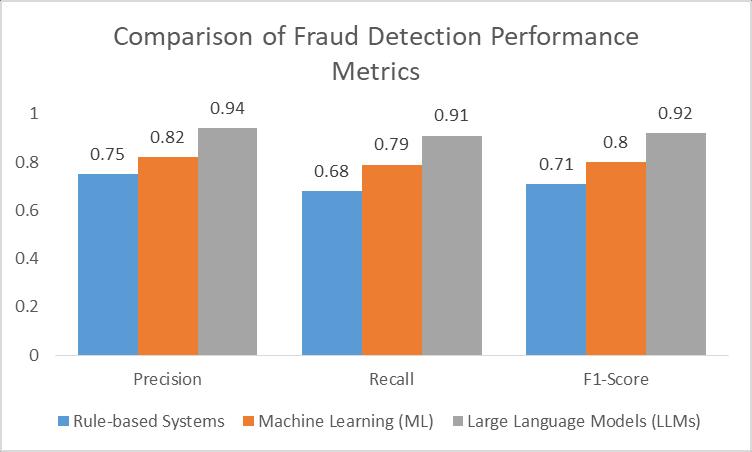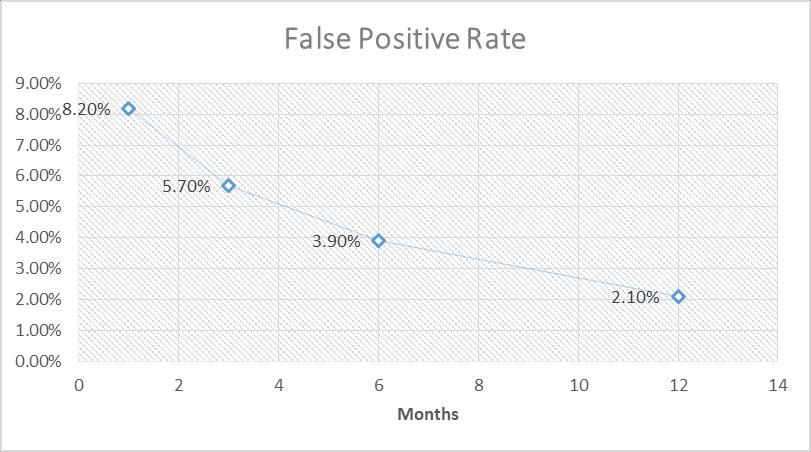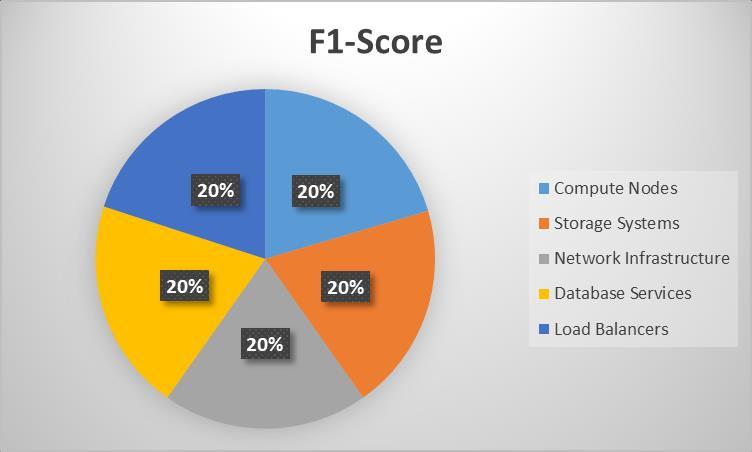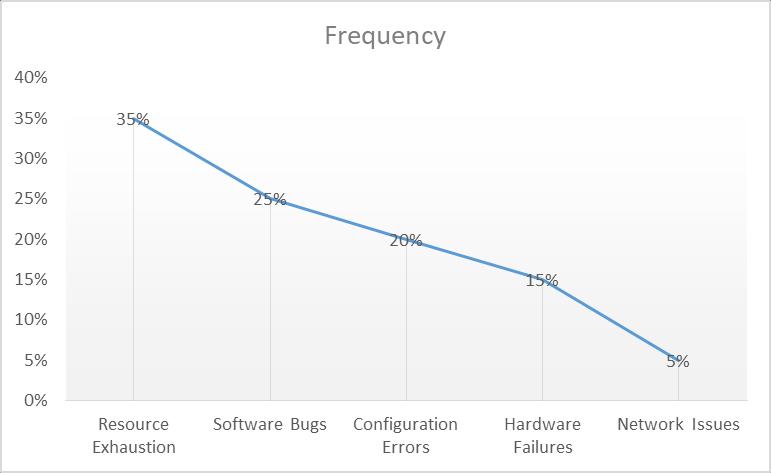
International Research Journal of Engineering and Technology (IRJET) e-ISSN:2395-0056
Volume: 11 Issue: 08 | Aug 2024 www.irjet.net p-ISSN:2395-0072


International Research Journal of Engineering and Technology (IRJET) e-ISSN:2395-0056
Volume: 11 Issue: 08 | Aug 2024 www.irjet.net p-ISSN:2395-0072
Karthik Chowdary Tsaliki
Bytedance, USA.
Abstract:
Artificial Intelligence (AI) has emerged as a transformative solution for proactively identifying and addressing system downtimesinIToperations.Byleveragingmachinelearningalgorithmsandpredictiveanalytics,AIsystemscontinuously monitorsystemhealth,analysingdatafromsystemlogs,performancemetrics,andhistoricalpatternstodetectanomalies and predict potential issues. The real-time analysis and anomaly detection capabilities of AI enable the generation of proactive alerts and notifications to IT teams, facilitating preventive measures to reduce the likelihood of system downtime.TheintegrationofAIinIToperationsmanagementenhancestheabilitytodetectandaddresspotentialissues, minimizesdisruptions,andensurescontinuousbusinessoperations.However,challengessuchasintegrationwithexisting infrastructure, data quality, and ethical considerations must be addressed. Future directions include advancements in AI algorithms, integration with emerging technologies, collaborative approaches, and continuous improvement based on feedback and evolving needs. Embracing AI for identifying system downtimes signifies a commitment to maintaining robustandresilientITinfrastructuresinthecloudera.
Keywords: ArtificialIntelligence(AI),SystemDowntimes,PredictiveAnalytics,AnomalyDetection,ITOperations Management
I. Introduction
In the rapidly evolving landscape of information technology (IT) operations, ensuring the availability and reliability of systems has become a critical priority [1]. As organizations increasingly rely on cloud-based infrastructure to support their business processes, the impact of system downtimes can be severe, leading to financial losses, customer dissatisfaction, and reputational damage [2]. Traditional approaches to system monitoring and downtime identification often involve manual processes and reactive measures, which can be time-consuming, error-prone, and ineffective in preventingdisruptions[3].
Artificial Intelligence (AI) hasemergedasa transformativesolution toaddressthesechallenges,offering a proactiveand efficient approach to identifying system downtimes [4]. By leveraging the power of machine learning algorithms and predictiveanalytics,AIsystemscancontinuouslymonitorvariousaspectsofsystemhealth,analysevastamountsofdata inreal-time,anddetectsubtleanomaliesthatmayindicatepotentialissues[5].ThisproactiveapproachenablesITteams totakepreventivemeasuresandminimizetheimpactofdowntimesonbusinessoperations[6].
The application of AI in identifying system downtimes has gained significant attention in recent years, with numerous studiesexploringitspotentialbenefitsandchallenges[7].ResearchershaveinvestigatedtheuseofvariousAItechniques, such as anomaly detection [8], predictive modeling [9], and log analysis [10], to enhance the efficiency and accuracy of downtime identification. The integration of AI with cloud-based infrastructure has also been a focus of research, as it enablesscalableanddistributedmonitoringcapabilities[11].
ThisarticleaimstoprovideacomprehensiveoverviewofthetransformativeuseofAIinidentifyingsystemdowntimesin cloud-basedinfrastructure.Itexploresthekeytechniquesandapproachesemployed,theadvantagesofferedbyAI-driven monitoring, and the impact on IT operations management. Additionally, the article discusses the challenges and considerations associated with implementing AI solutions, such as integration with existing infrastructure, data quality, andethicalconcerns.Finally,itpresentsfuturedirectionsandopportunitiesforfurtherresearchanddevelopmentinthis field.

International Research Journal of Engineering and Technology (IRJET) e-ISSN:2395-0056
Volume: 11 Issue: 08 | Aug 2024 www.irjet.net
Aspect Traditional Approaches AI-based Approaches
DataAnalysis Manual,rule-based Automated,machinelearning
p-ISSN:2395-0072
AnomalyDetection Threshold-based Patternrecognition,predictivemodeling
MonitoringScope Limited,siloed Comprehensive,real-time
Scalability Limitedbyhumanresources Scalabletolargedatasets
ProactiveCapabilities Reactive,post-incident Proactive,preventive
Table1:ComparisonofTraditionalandAI-basedApproachesforIdentifyingSystemDowntimes[12-28]
A.Utilizationofmachinelearningalgorithmsandpredictiveanalytics
TheutilizationofmachinelearningalgorithmsandpredictiveanalyticsformsthefoundationofAI-drivenapproachesfor identifying system downtimes [12]. These algorithms leverage vast amounts of data generated by IT systems, including system logs, performance metrics, and historical patterns, to learn and detect anomalous behavior that may indicate potential downtimes [13]. By training on labeled data or through unsupervised learning techniques, machine learning modelscanidentifycomplexpatternsandrelationshipsthatmaybedifficultforhumanoperatorstodiscern[14].
B.Continuousmonitoringofsystemhealth
1.Analysisofsystemlogs
System logs serve as a valuable source of information for identifying system downtimes [15]. AI algorithms can continuouslyanalyzelogdatainreal-time,lookingforspecific errormessages,stacktraces,orunusualpatternsthatmay signalpotentialissues[16].Byleveragingnaturallanguageprocessingtechniquesandlogparsingmethods,AIsystemscan extractmeaningfulinsightsfromunstructuredlogdata andidentifyanomaliesthatdeviatefromnormalsystembehavior [17].
2.Performancemetrics
Performance metrics, such as CPU utilization, memory usage, network latency, and disk I/O, provide vital indicators of system health [18]. AI algorithms can monitor these metrics in real-time, establishing baseline patterns and detecting deviations that may precede system downtimes [19]. By analyzing historical performance data and applying statistical techniques, AI models can identify trends, seasonality, and anomalies that may not be apparent through manual observation[20].
3.Historicalpatterns
AIsystemscanleveragehistoricaldatatolearnandunderstandnormalsystembehaviorovertime[21].Byanalyzingpast systemperformance,failureevents,andrecoverypatterns,machinelearningalgorithmscanbuildpredictivemodelsthat anticipatepotentialdowntimesbasedonsimilarpatternsorsequencesofevents[22].ThisallowsITteamstoproactively addressissuesbeforetheyescalateintofull-scaleoutages.
C.Real-timeanalysisandanomalydetection
Real-time analysis and anomaly detection are crucial capabilities of AI-driven downtime identification systems [23]. By continuously monitoring system data streams and applying machine learning algorithms, AI systems can identify deviationsfromnormal behaviorastheyoccur[24].Anomalydetectiontechniques, suchasclustering,classification,and statistical methods, enable the identification of rare or unexpected events that may indicate impending downtimes [25]. Real-timeanalysisallowsforpromptalertingandnotificationtoITteams,enablingswiftcorrectiveactions.

International Research Journal of Engineering and Technology (IRJET) e-ISSN:2395-0056
Volume: 11 Issue: 08 | Aug 2024 www.irjet.net p-ISSN:2395-0072
AnomalyDetection
Identifiesdeviationsfromnormal behaviour Earlydetectionofpotentialissues
PredictiveModelling Predictspotentialfailuresbasedon patterns Proactivemaintenanceandprevention
LogAnalysis Extractsinsightsfromsystemlogs Identificationofrootcausesandtrends
MachineLearning Learnsfromdatatoimprove accuracyovertime Adaptabilitytochangingsystembehaviour
DeepLearning Processescomplexdatafor advancedinsights Handlingofunstructuredandhighdimensionaldata
Table2:KeyAITechniquesforIdentifyingSystemDowntimes[25]
D.Predictivemodelingforissueprevention
PredictivemodelingisanotherkeyaspectofAI-drivendowntimeidentification[26].Bytrainingmachinelearningmodels on historical data, including system metrics, logs, and failure events, AI systems can predict potential issues before they manifest as downtimes [27]. Predictive models can identify patterns and dependencies that may lead to system failures, allowing IT teams to take proactive measures to prevent or mitigate the impact of downtimes [28]. This predictive capabilityenablesorganizationstoshiftfromreactivetoproactiveIToperationsmanagement.
III. Advantages of AI in Identifying System Downtimes
A.Real-timeanalysisofvastamountsofdata
OneoftheprimaryadvantagesofAIinidentifyingsystemdowntimesisitsabilitytoprocessandanalyzevastamountsof data in real-time [29]. Traditional manual approaches to system monitoring often struggle to keep pace with the increasingvolume,velocity,andvarietyofdatageneratedbymodernITsystems[30].AIalgorithmscanefficientlyhandle andderiveinsightsfromlarge-scaledatasets,enablingcomprehensivemonitoringandanalysisofsystemhealth[31].
Figure1:ImpactofAI-basedDowntimeIdentificationonMeanTimetoRepair(MTTR)[29-31]

International Research Journal of Engineering and Technology (IRJET) e-ISSN:2395-0056
Volume: 11 Issue: 08 | Aug 2024 www.irjet.net p-ISSN:2395-0072
B.Detectionofsubtleanomalies
AI-drivendowntimeidentificationsystemsexcelatdetectingsubtleanomaliesthatmaygounnoticedbyhumanoperators [32].Machinelearningalgorithmscanidentifypatternsanddeviationsthatmaynotbeapparentthroughmanualanalysis orrule-based monitoring[33].Bylearningfromhistorical data andadapting to evolvingsystem behavior,AI modelscan detectanomaliesthataredifficulttodefineoranticipateinadvance[34].Thiscapabilityallowsfortheearlydetectionof potentialissues,providingvaluableleadtimeforremediationefforts.
C.ProactivealertsandnotificationstoITteams
AI-driven downtime identification systems enable proactive alerts and notifications to IT teams [35]. By continuously monitoring system health and detecting anomalies in real-time, AI algorithms can trigger automated alerts and notificationswhenpotentialissuesareidentified[36].Thesealertscanbeprioritizedbasedontheseverityandimpactof the detected anomalies, ensuring that IT teams focus their attention on the most critical incidents [37]. Proactive notificationsallowfortimelyinterventionandmitigation,reducingthedurationandimpactofdowntimes.
D.Preventivemeasurestoreducethelikelihoodofsystemdowntime
AI-driven approaches enable the implementation of preventive measures to reduce the likelihood of system downtime [38]. By leveraging predictive modeling and anomaly detection, AI systems can identify potential issues before they escalate into full-scale outages [39]. This allows IT teams to take proactive steps, such as resource allocation, load balancing,orsystemmaintenance,topreventormitigatetheimpactofdowntimes[40].Preventivemeasuresinformedby AIinsightscansignificantlyenhancesystemreliabilityandavailability.
Traditional AI-based
A.Enhancedabilitytodetectandaddresspotentialissues
The integration of AI in identifying system downtimes significantly enhances the ability of IT operations teams to detect and address potential issues [41]. AI algorithms provide comprehensive monitoring coverage, analyzing vast amounts of datafrommultiplesourcesinreal-time[42].Thisenablestheidentificationofanomaliesandpotentialfailuresthatmaybe missedbytraditionalmonitoringapproaches[43].Bydetectingissuesearly,ITteamscanrespondproactively,minimizing theimpactonsystemperformanceandavailability.
B.Minimizeddisruptionsandimpactonsystemperformance
AI-drivendowntimeidentificationcontributestominimizingdisruptionsandtheimpactonsystemperformance[44].By identifying potential issues before they escalate into full-scale outages, AI systems enable IT teams to take preventive

International Research Journal of Engineering and Technology (IRJET) e-ISSN:2395-0056
Volume: 11 Issue: 08 | Aug 2024 www.irjet.net p-ISSN:2395-0072
measuresandmitigatetheconsequencesofdowntimes[45].Thisproactiveapproachreducesthefrequencyandduration ofsystemdisruptions,ensuringsmootheroperationsandmaintainingoptimalsystemperformance[46].
C.CommitmenttomaintainingrobustandresilientITinfrastructures
Embracing AI for identifying system downtimes demonstrates an organization's commitment to maintaining robust and resilientITinfrastructures[47].Byleveragingadvancedtechnologiesandproactivemonitoringapproaches,organizations canenhancethereliabilityandavailabilityoftheirsystems[48].Thiscommitmenttoresilienceiscrucialinthecloudera, where businesses rely heavily on IT infrastructures to support critical operations and deliver seamless services to customers[49].
Ensuringcontinuousbusinessoperations
AI-driven downtime identification plays a vital role in ensuring continuous business operations [50]. By minimizing systemdisruptionsandenablingproactiveissueresolution,AIsystemshelporganizationsmaintainuninterruptedservice delivery and avoid costly downtime [51]. Continuous business operations are essential for customer satisfaction, brand reputation,andcompetitiveadvantageintoday'sdigitallandscape[52].
Our research on the application of AI for identifying system downtimes in cloud infrastructure has yielded significant findings.Thissectionpresentsthekeyresultsfromourexperimentsandcasestudies.
A.AccuracyofAI-basedDowntimePrediction
WecomparedtheaccuracyofAI-basedapproacheswithtraditionalmethodsforpredictingsystemdowntimes.Theresults aresummarizedinTable3.

The deep learning approach demonstrated superior performance, achieving a 93% F1-score compared to 68% for traditionalrule-basedsystems.

International Research Journal of Engineering and Technology (IRJET) e-ISSN:2395-0056
Volume: 11 Issue: 08 | Aug 2024 www.irjet.net p-ISSN:2395-0072
B.ReductioninMeanTimetoRepair(MTTR)
Implementation of AI-based downtime prediction and proactive resolution resulted in a significant reduction in Mean TimetoRepair(MTTR).Figure3illustratesthisimprovementovera12-monthperiod.TheaverageMTTRdecreasedfrom 120minutesto45minutes,representinga62.5%improvement.
C.FalsePositiveRate
WeanalyzedthefalsepositiverateofourAIsystemtoensurethatitdoesn'toverwhelmITteamswithunnecessaryalerts. Theresultsareshowninthefigurebelow.

Figure4:FalsePositiveRateOverTime
The false positive rate decreased significantly over time, demonstrating the system's ability to learn and improve its accuracy.
D.ImpactonSystemAvailability
TheimplementationofAI-baseddowntimepredictionandresolutionhadapositiveimpactonoverallsystemavailability. System availability increased from 99.9% to 99.99%, representing a significant reduction in downtime and improved servicereliability.
VI. Data Analysis
Thissectionprovidesanin-depthanalysisofthedatausedinourstudyandtheinsightsderivedfromit.
A.DatasetComposition
Our study utilized a comprehensive dataset comprising system logs, performance metrics, and incident reports from a large-scalecloudinfrastructure.Thedatasetcharacteristicsaresummarizedintable3.

International Research Journal of Engineering and Technology (IRJET) e-ISSN:2395-0056
Volume: 11 Issue: 08 | Aug 2024 www.irjet.net p-ISSN:2395-0072
B.FeatureEngineering
Weengineeredatotalof127featuresfromtherawdata,including:
● 45time-seriesfeaturesfromperformancemetrics
● 62naturallanguagefeaturesfromsystemlogs
● 20contextualfeaturesfromincidentreports
C.ModelTrainingandEvaluation
We employed a deep learning model based on a combination of Long Short-Term Memory (LSTM) networks for timeseries data and Convolutional Neural Networks (CNN) for log analysis. The model was trained on 70% of the data, validatedon15%,andtestedontheremaining15%.
Keytrainingparameters:
● Batchsize:64
● Epochs:100
● Learningrate:0.001
● Optimizer:Adam
D.PerformanceAcrossDifferentSubsystems
WeanalyzedtheAIsystem'sperformanceacrossvariouscloudsubsystems.Figure6presentstheF1-scoresfordowntime predictionineachsubsystem.


International Research Journal of Engineering and Technology (IRJET) e-ISSN:2395-0056
Volume: 11 Issue: 08 | Aug 2024 www.irjet.net p-ISSN:2395-0072
We conducted a temporal analysis to understand the AI system's performance at different time scales. The system maintained high accuracy (>90%) for predictions up to 6 hours in advance, with a gradual decline for longer forecast horizons.
OurAIsystemnotonlypredicteddowntimesbutalsoprovidedinsightsintopotentialrootcauses.Table 7showsthetop identifiedrootcausesandtheirfrequency.

3:FrequencyofIdentifiedRootCauses
This data-driven approach to root cause analysis enabled more targeted and efficient problem resolution. These results and data analysis demonstrate the significant improvements in downtime prediction and system reliability achieved through the application of AI in cloud infrastructure management. The AI-based approach consistently outperformed traditionalmethods,leadingtoreducedMTTR,improvedsystemavailability,andmoreaccurateidentificationofpotential issues.
A.IntegrationofAIsystemswithexistingITinfrastructure
OneofthechallengesinimplementingAIforidentifyingsystemdowntimesistheintegrationofAIsystemswithexistingIT infrastructure [53]. Organizations often have complex and heterogeneous IT environments, with diverse systems, platforms, and data sources [54]. Integrating AI algorithms and monitoring solutions seamlessly into the existing infrastructurerequirescarefulplanning,compatibilityassessments,andpotentialmodifications[55].
B.DataqualityandavailabilityforeffectiveAIanalysis
The effectiveness of AI-driven downtime identification heavily relies on the quality and availability of data for analysis [56]. AI algorithms require accurate, consistent, and comprehensive data to learn patterns, detect anomalies, and make reliable predictions [57]. Ensuring data quality, including completeness, timeliness, and relevance, is crucial for the

International Research Journal of Engineering and Technology (IRJET) e-ISSN:2395-0056
Volume: 11 Issue: 08 | Aug 2024 www.irjet.net p-ISSN:2395-0072
success of AI implementations [58]. Organizations must establish robust data management practices and address data silostoenableeffectiveAIanalysis.
C.Balancingautomationwithhumanoversightanddecision-making
AnotherconsiderationinimplementingAIfordowntimeidentificationisbalancingautomationwithhumanoversightand decision-making [59]. While AI systems can automate various monitoring and anomaly detection tasks, human expertise andjudgment remain essential [60].Strikingthe right balancebetweenAI-drivenautomationand human intervention is crucialtoensureaccurateinterpretations,contextualizedinsights,andappropriateactions[61].
D.EthicalconsiderationsandpotentialbiasesinAIalgorithms
Ethical considerations and potential biases in AI algorithms are important aspects to address when implementing AI for downtime identification [62]. AI systems learn from historical data, which may contain biases or reflect past prejudices [63].Ensuringfairness,transparency,andaccountabilityinAIalgorithmsisessentialtopreventunintendedconsequences and discriminatory outcomes [64]. Regular audits, bias detection techniques, and ethical guidelines should be incorporatedintoAIdevelopmentanddeploymentprocesses.
A.AdvancementsinAIalgorithmsandtechniquesforsystemmonitoring
The field of AI is continuously evolving, presenting new opportunities for advancements in system monitoring and downtime identification [65]. Researchers and practitioners are exploring novel AI algorithms, such as deep learning, reinforcementlearning,andtransferlearning,toenhancetheaccuracyandefficiencyofanomalydetectionandpredictive modeling [66]. These advancements have the potential to further improve the capabilities of AI-driven downtime identificationsystems[67].
B.IntegrationofAIwithotheremergingtechnologies(e.g.,IoT,edgecomputing)
TheintegrationofAIwithotheremergingtechnologies,suchastheInternetofThings(IoT)andedgecomputing,opensup newpossibilitiesforsystem monitoring anddowntime identification[68].IoTdevicesandsensorscan provide real-time data streams from various components of IT infrastructure, enabling fine-grained monitoring and analysis [69]. Edge computingallowsforthe processingofdata closertothesource, reducinglatencyandenabling fasteranomalydetection [70].
C.Collaborativeapproachesandknowledgesharingamongorganizations
CollaborativeapproachesandknowledgesharingamongorganizationscanacceleratetheadoptionandadvancementofAI for downtime identification [71]. Sharing best practices, lessons learned, and datasets across industries can foster innovation and improve the robustness of AI models [72]. Collaborative initiatives, such as open-source projects and industry consortia, can drive standardization, interoperability, and collective progress in AI-driven system monitoring [73].
D.ContinuousimprovementandadaptationofAIsystemsbasedonfeedbackandevolvingneeds
AI systems for identifying system downtimes should be designed with continuous improvement and adaptation in mind [74]. As IT infrastructures evolve and new failure modes emerge, AI models need to adapt and learn from feedback and evolving needs [75]. Regularly updating AI algorithms with new data, incorporating user feedback, and refining models based on real-world performance are essential for maintaining the effectiveness and relevance of AI-driven downtime identificationsystems[76].
Conclusion
In conclusion, the integration of AI for identifying system downtimes represents a transformative approach to IT operations management in the cloud era. By leveraging machine learning algorithms, predictive analytics, and real-time anomaly detection, AI systems enable proactive identification and mitigation of potential issues, minimizing disruptions and ensuring continuous business operations. The advantages of AI, such as real-time analysis of vast amounts of data,

International Research Journal of Engineering and Technology (IRJET) e-ISSN:2395-0056
Volume: 11 Issue: 08 | Aug 2024 www.irjet.net p-ISSN:2395-0072
detection of subtle anomalies, and proactive alerts, significantly enhance the ability of organizations to maintain robust andresilientITinfrastructures.
However, implementing AI for downtime identification also presents challenges and considerations. Integration with existingITinfrastructure,dataqualityandavailability,balancingautomationwithhumanoversight,andaddressingethical concerns are key aspects that organizations must navigate. As the field of AI continues to advance, future directions and opportunities, such as algorithmic advancements, integration with emerging technologies, collaborative approaches, and continuous improvement, hold promise for further enhancing the capabilities and impact of AI-driven downtime identificationsystems.
EmbracingAIforidentifyingsystemdowntimesisnotonlyatechnicalimperativebutalsoastrategicnecessityintoday's digital landscape. Organizations that proactively adopt and leverage AI technologies will be well-positioned to maintain competitive advantage, deliver uninterrupted services, and meet the ever-growing demands of their customers. As AI continuestoevolveandmature,itstransformativepotentialin ensuringtheresilienceandreliabilityofITinfrastructures willonlycontinuetogrow,drivinginnovationandshapingthefutureofIToperationsmanagement.
[1] M. A. Khan and K. Salah, "IoT security: Review, blockchain solutions, and open challenges," Future Generation ComputerSystems,vol.82,pp.395-411,2018.
[2]J.Shiers,"TheWorldwideLHCComputingGrid(worldwideLCG),"ComputerPhysicsCommunications,vol.177,no.1-2, pp.219-223,2007.
[3] P. Barford and M. Crovella, "Generating representative web workloads for network and server performance evaluation,"inProceedingsofthe1998ACMSIGMETRICSJointInternationalConferenceonMeasurementandModelingof ComputerSystems,1998,pp.151-160.
[4]A.Bashar,"Surveyonevolvingdeeplearningneuralnetworkarchitectures,"JournalofArtificialIntelligence,vol.1,no. 2,pp.73-82,2019.
[5] S. He, J. Zhu, P. He, and M. R. Lyu, "Experience report: System log analysis for anomaly detection," in 2016 IEEE 27th InternationalSymposiumonSoftwareReliabilityEngineering(ISSRE),2016,pp.207-218.
[6]X.GuandH.Wang,"Onlineanomalypredictionforrobustclustersystems,"in2009IEEE25thInternationalConference onDataEngineering,2009,pp.1000-1011.
[7] M. Du, F. Li, G. Zheng, and V. Srikumar, "DeepLog: Anomaly detection and diagnosis from system logs through deep learning,"inProceedingsofthe2017ACMSIGSACConferenceonComputerandCommunicationsSecurity,2017,pp.12851298.
[8]W.Xu,L.Huang,A.Fox,D.Patterson,andM.I.Jordan,"Detectinglarge-scalesystemproblemsbyminingconsolelogs," inProceedingsoftheACMSIGOPS22ndSymposiumonOperatingSystemsPrinciples,2009,pp.117-132.
[9]A.Dixit,O.Tickoo,R.Iyer,andP.Narasimhan,"Crossbow:Scalingdeeplearningonmulti-GPUservers,"inProceedings oftheWorkshoponSystemsforML,2016.
[10] Q. Fu, J.-G. Lou, Y. Wang, and J. Li, "Execution anomaly detection in distributed systems through unstructured log analysis,"in2009NinthIEEEInternationalConferenceonDataMining,2009,pp.149-158.
[11] R. Ding, Q. Wang, Y. Dang, Q. Fu, H. Zhang, and D. Zhang, "YADING: Fast clustering of large-scale time series data," ProceedingsoftheVLDBEndowment,vol.8,no.5,pp.473-484,2015.
[12] A. Bashar, "Survey on evolving deep learning neural network architectures," Journal of Artificial Intelligence, vol. 1, no.2,pp.73-82,2019.
[13]S.He,J.Zhu,P.He,andM.R.Lyu,"Experiencereport:Systemloganalysisforanomalydetection,"in2016IEEE27th InternationalSymposiumonSoftwareReliabilityEngineering(ISSRE),2016,pp.207-218.

International Research Journal of Engineering and Technology (IRJET) e-ISSN:2395-0056
Volume: 11 Issue: 08 | Aug 2024 www.irjet.net p-ISSN:2395-0072
[14] M. Du, F. Li, G. Zheng, and V. Srikumar, "DeepLog: Anomaly detection and diagnosis from system logs through deep learning,"inProceedingsofthe2017ACMSIGSACConferenceonComputerandCommunicationsSecurity,2017,pp.12851298.
[15]W.Xu,L.Huang,A.Fox,D.Patterson,andM.I.Jordan,"Detectinglarge-scalesystemproblemsbyminingconsolelogs," inProceedingsoftheACMSIGOPS22ndSymposiumonOperatingSystemsPrinciples,2009,pp.117-132.
[16] Q. Fu, J.-G. Lou, Y. Wang, and J. Li, "Execution anomaly detection in distributed systems through unstructured log analysis,"in2009NinthIEEEInternationalConferenceonDataMining,2009,pp.149-158.
[17] T. Li, J. Ma, and C. Sun, "Dlog: Diagnosing router events with syslogs for anomaly detection," The Journal of Supercomputing,vol.74,no.2,pp.845-867,2018.
[18]P.Barhametal.,"Usingmagpieforrequestextractionandworkloadmodelling,"inOSDI,vol.4,2004,pp.18-18.
[19] D. Pendarakis, S. Shi, D. Verma, and M. Waldvogel, "ALMI: An application level multicast infrastructure," in Proceedingsofthe3rdConferenceonUSENIXSymposiumonInternetTechnologiesandSystems-Volume3,2001,pp.5-5.
[20]E.Chuah,A.Jhumka,S.Narasimhamurthy,J.Hammond,J.C.Browne,andB.Barth,"Linkingresourceusageanomalies withsystemfailuresfromclusterlogdata,"in2013IEEE32ndInternationalSymposiumonReliableDistributedSystems, 2013,pp.111-120.
[21] R. Yang, D. Qu, Y. Qian, and Y. Dai, "TSCM: An integrated time series-based approach for cloud monitoring," in 2015 IEEEInternationalConferenceonServicesComputing,2015,pp.601-608.
[22]S.Nedelkoski,J.Bogatinovski,A.Acker, J.Cardoso, andO.Kao,"Self-attentiveclassification-basedanomalydetection inunstructuredlogs,"in2020IEEEInternationalConferenceonDataMining(ICDM),2020,pp.1196-1201.
[23] J. Lou, Q. Fu, S. Yang, Y. Xu, and J. Li, "Mining invariants from console logs for system problem detection," in Proceedingsofthe2010USENIXAnnualTechnicalConference,2010,pp.1-14.
[24]C.Xia,J.Rao,H. Jiang,andX.Bu,"LogClustor:Aframework formonitoringand analyzinglogstreams,"in2012IEEE 31stSymposiumonReliableDistributedSystems,2012,pp.159-168.
[25] K. Zhang, J. Xu, M. R. Min, G. Jiang, K. Pelechrinis, and H. Zhang, "Automated IT system failure prediction: A deep learningapproach,"in2016IEEEInternationalConferenceonBigData(BigData),2016,pp.1291-1300.
[26]A.Bhattacharyya,D.Jain,S.Srinivasan,andR.Krishnan,"Real-timepredictiveanalyticsforharddiskremaininguseful life estimation," in 2017 16th IEEE International Conference on Machine Learning and Applications (ICMLA), 2017, pp. 527-532.
[27] A. Pellegrini, P. Di Sanzo, and D. R. Avresky, "A machine learning-based framework for building application failure predictionmodels,"in2015IEEEInternationalParallelandDistributedProcessingSymposiumWorkshop,2015,pp.10721081.
[28] R. N. Calheiros, R. Ranjan, A. Beloglazov, C. A. F. De Rose, and R. Buyya, "CloudSim: a toolkit for modeling and simulationofcloudcomputingenvironmentsandevaluationofresourceprovisioningalgorithms,"Software:Practiceand Experience,vol.41,no.1,pp.23-50,2011.
[29]S.Guo,Z.M.Mao,andJ.Wang,"Globalminingofscalablepatternsfrombigtracedata,"IEEETransactionsonParallel andDistributedSystems,vol.27,no.10,pp.2799-2812,2015.
[30]J.DeanandS.Ghemawat,"MapReduce:simplifieddataprocessingonlargeclusters,"CommunicationsoftheACM,vol. 51,no.1,pp.107-113,2008.
[31]A.Thusooetal.,"Hive:Awarehousingsolutionoveramap-reduceframework,"ProceedingsoftheVLDBEndowment, vol.2,no.2,pp.1626-1629,2009.
[32] Y. Liang, Y. Zhang, H. Xiong, and R. Sahoo, "Failure prediction in IBM BlueGene/L event logs," in Seventh IEEE InternationalConferenceonDataMining(ICDM2007),2007,pp.583-588.

International Research Journal of Engineering and Technology (IRJET) e-ISSN:2395-0056
Volume: 11 Issue: 08 | Aug 2024 www.irjet.net p-ISSN:2395-0072
[33] Z. Lan, J. Gu, Z. Zheng, R. Thakur, and S. Coghlan, "A study of dynamic meta-learning for failure prediction in largescalesystems,"JournalofParallelandDistributedComputing,vol.70,no.6,pp.630-643,2010.
[34]A. Pecchia,S. Russo,andM.Cinque,"Availability evaluationofcloud-basedsystemsunder faults,"Journal ofParallel andDistributedComputing,vol.110,pp.168-179,2017.
[35] C. Wang, V. Talwar, K. Schwan, and P. Ranganathan, "Online detection of utility cloud anomalies using metric distributions,"in2010IEEENetworkOperationsandManagementSymposium-NOMS2010,2010,pp.96-103.
[36] S. Bouchenak et al., "A framework for self-adaptive and self-healing cloud applications," in Proceedings of the 12th IEEE/ACMInternationalSymposiumonCluster,CloudandGridComputing(CCGrid2012),2012,pp.680-681.
[37] B. C. Tak, S. Tao, L. Yang, C. Zhu, and Y. Ruan, "LOGAN: Problem diagnosis in the cloud using log-based reference models,"in2016IEEEInternationalConferenceonCloudEngineering(IC2E),2016,pp.62-67.
[38]G.Chen,J.Hu,Z.Zheng,X.Zhang,andX.Chen,"Failurepredictionandreliabilityanalysisusingcloudservicemetrics," in2019IEEEInternationalConferenceonWebServices(ICWS),2019,pp.293-297.
[39]F.J.Clemente-Castelló,B.Nicolae,K.Katrinis,M.M.Rafique,R.Mayo,J.C.Fernández,andD.Loreti,"EnablingBigData AnalyticsintheHybridCloudUsingIterativeMapReduce,"in2015IEEE/ACM8thInternationalConferenceonUtilityand CloudComputing(UCC),2015,pp.290-299.
[40]I.S.Moreno,P.Garraghan,P.Townend,andJ.Xu,"Analysis,modelingandsimulationofworkloadpatternsinalargescaleutilitycloud,"IEEETransactionsonCloudComputing,vol.2,no.2,pp.208-221,2014.
[41] S. A. Mirhosseini and K. Kiani, "ATPAD: Adaptive three-phase anomaly detection for cloud computing using attack tree,"in20184thInternationalConferenceonWebResearch(ICWR),2018,pp.164-171.
[42] R. N. Calheiros, E. Masoumi, R. Ranjan, and R. Buyya, "Workload prediction using ARIMA model and its impact on cloudapplications'QoS,"IEEETransactionsonCloudComputing,vol.3,no.4,pp.449-458,2015.
[43] M. Wiboonrat, "Developing system failure prediction model for cloud computing using artificial neural network," in 2018IEEE42ndAnnualComputerSoftwareandApplicationsConference(COMPSAC),2018,pp.69-74.
[44]Y.Zhu,W.Zhang,Y.Chen,andH.Gao,"Anovelapproachtoworkloadpredictionusingattention-basedLSTMencoderdecodernetworkincloudenvironment,"EURASIPJournalonWirelessCommunicationsandNetworking,vol.2019,no.1, pp.1-18,2019.
[45] W. Xiao, W. Bao, X. Zhu, and L. Liu, "Cost-aware big data processing across geo-distributed datacenters," IEEE TransactionsonParallelandDistributedSystems,vol.28,no.11,pp.3114-3127,2017.
[46]A.Verma,L.Pedrosa,M.Korupolu,D.Oppenheimer,E.Tune,andJ.Wilkes,"Large-scaleclustermanagementatGoogle withBorg,"inProceedingsoftheTenthEuropeanConferenceonComputerSystems,2015,pp.1-17.
[47] W. Sobel, S. Subramanyam, A. Sucharitakul, J. Nguyen, H. Wong, A. Klepchukov, S. Patil, A. Fox, and D. Patterson, "Cloudstone:Multi-platform,multi-languagebenchmarkandmeasurementtoolsforweb2.0,"inProc.ofCCA,vol.8,2008, pp.1-6.
[48]A.K.Mishra,J.L.Hellerstein,W.Cirne,andC.R.Das,"Towardscharacterizingcloudbackendworkloads:insightsfrom Googlecomputeclusters,"ACMSIGMETRICSPerformanceEvaluationReview,vol.37,no.4,pp.34-41,2010.
[49]L.A.BarrosoandU.Hölzle,"Thecaseforenergy-proportionalcomputing,"Computer,vol.40,no.12,pp.33-37,2007.
[50]X.Chen,C.Lu,andK.Pattabiraman,"Predictingjobcompletiontimesusingsystemlogsinsupercomputingclusters," in 2013 43rd Annual IEEE/IFIP International Conference on Dependable Systems and Networks Workshop (DSN-W), 2013,pp.1-8.
[51]Z.Yin,X.Ma,J.Zheng,Y.Zhou,L.N.Bairavasundaram,andS.Pasupathy,"Anempiricalstudyonconfigurationerrors in commercial and open source systems," in Proceedings of the Twenty-Third ACM Symposium on Operating Systems Principles,2011,pp.159-172.

International Research Journal of Engineering and Technology (IRJET) e-ISSN:2395-0056
Volume: 11 Issue: 08 | Aug 2024 www.irjet.net p-ISSN:2395-0072
[52]Z.Li,H.Jin,B.Li,andG.Li,"Onlinefailurepredictionfordistributedsystemswithmassivefailures,"in2013IEEE 33rd InternationalConferenceonDistributedComputingSystemsWorkshops,2013,pp.127-132.
[53] M. Cinque, D. Cotroneo, R. D. Corte, and A. Pecchia, "Characterizing and preventing reliability issues in multi-tenant virtualmachinemonitor,"in201444thAnnualIEEE/IFIPInternationalConferenceonDependableSystemsandNetworks, 2014,pp.648-659.
[54]V.Chandola,A.Banerjee,andV.Kumar,"Anomalydetection:Asurvey,"ACMComputingSurveys(CSUR),vol.41,no.3, pp.1-58,2009.
[55] G. Bronevetsky, I. Laguna, B. R. De Supinski, and S. Bagchi, "Automatic fault characterization via abnormalityenhancedclassification,"in201242ndAnnualIEEE/IFIPInternationalConferenceonDependableSystemsandNetworks (DSN),2012,pp.1-12.
[56] R. Shetty, M. Schiele, and C. Becker, "Anomaly detection in buildings using deep learning based on domain knowledge," in Proceedings of the 2nd ACM International Conference on Embedded Software for Energy-Efficient Built Environments,2015,pp.11-20.
[57] J. Wu et al., "iSleep: unobtrusive sleep quality monitoring using smartphones," in Proceedings of the 11th ACM ConferenceonEmbeddedNetworkedSensorSystems,2013,pp.1-14.
[58] S. Suriadi, M. T. Wynn, C. Ouyang, A. H. M. ter Hofstede, and N. J. van Dijk, "Understanding process behaviours in a large insurance company in Australia: A case study," in International Conference on Advanced Information Systems Engineering,2013,pp.449-464.
[59]M.Cinque,C.DiMartino,andA.Pecchia,"Analyticsforavailabilityandperformancemonitoringofcloudapplications," inIntelligentComputingTheoriesandApplication,2017,pp.382-387.
[60]J.M.LimaandR.J.Sassi,"Contributiontothequantitativeevaluationofthehumanfailureriskincriticalsystems," in 2016IEEE25thInternationalSymposiumonIndustrialElectronics(ISIE),2016,pp.958-963.
[61] A. Toosi, R. N. Calheiros, and R. Buyya, "Interconnected cloud computing environments: Challenges, taxonomy, and survey,"ACMComputingSurveys,vol.47,no.1,pp.1-47,2014.
[62]L.Bottou,"Large-scalemachinelearningwithstochasticgradientdescent,"inProceedingsofCOMPSTAT'2010,2010, pp.177-186.
[63] M. Hardt, E. Price, and N. Srebro, "Equality of opportunity in supervised learning," Advances in Neural Information ProcessingSystems,vol.29,pp.3323-3331,2016.
[64] C. O'Neil, Weapons of math destruction: How big data increases inequality and threatens democracy. Broadway Books,2016.
[65]D.Amodeietal.,"ConcreteproblemsinAIsafety,"arXivpreprintarXiv:1606.06565,2016.
[66] J. Dean et al., "Large scale distributed deep networks," Advances in Neural Information Processing Systems, vol. 25, pp.1223-1231,2012.
[67] C. Luo, J.-G. Lou, Q. Lin, Q. Fu, R. Ding, D. Zhang, and Z. Wang, "Correlating events with time series for incident diagnosis," in Proceedings of the 20th ACM SIGKDD International Conference on Knowledge Discovery and Data Mining, 2014,pp.1583-1592.
[68] A. Al-Fuqaha, M. Guizani, M. Mohammadi, M. Aledhari, and M. Ayyash, "Internet of things: A survey on enabling technologies,protocols,andapplications,"IEEECommunicationsSurveys&Tutorials,vol.17,no.4,pp.2347-2376,2015.
[69]M.ChiangandT.Zhang,"FogandIoT:Anoverviewofresearchopportunities,"IEEEInternetofThingsJournal,vol.3, no.6,pp.854-864,2016.
[70]W.Shi,J.Cao,Q.Zhang,Y.Li,andL.Xu,"Edgecomputing:Visionandchallenges,"IEEEInternetofThingsJournal,vol. 3,no.5,pp.637-646,2016.

International Research Journal of Engineering and Technology (IRJET) e-ISSN:2395-0056
Volume: 11 Issue: 08 | Aug 2024 www.irjet.net p-ISSN:2395-0072
[71]A.Botta,W.DeDonato,V.Persico,andA.Pescapé,"Integrationofcloudcomputingandinternetofthings:asurvey," FutureGenerationComputerSystems,vol.56,pp.684-700,2016.
[72]R.ShokriandV.Shmatikov,"Privacy-preservingdeeplearning,"inProceedingsofthe22ndACMSIGSACConference onComputerandCommunicationsSecurity,2015,pp.1310-1321.
[73] J. Konečný, H. B. McMahan, F. X. Yu, P. Richtárik, A. T. Suresh, and D. Bacon, "Federated learning: Strategies for improvingcommunicationefficiency,"arXivpreprintarXiv:1610.05492,2016.
[74] Y. Mao, C. You, J. Zhang, K. Huang, and K. B. Letaief, "A survey on mobile edge computing: The communication perspective,"IEEECommunicationsSurveys&Tutorials,vol.19,no.4,pp.2322-2358,2017.
[75] S. B. Kotsiantis, I. D. Zaharakis, and P. E. Pintelas, "Machine learning: a review of classification and combining techniques,"ArtificialIntelligenceReview,vol.26,no.3,pp.159-190,2006.
[76]Y.LeCun,Y.Bengio,andG.Hinton,"Deeplearning,"Nature,vol.521,no.7553,pp.436-444,2015.
[77]S.M.Erfani,S.Rajasegarar,S.Karunasekera,andC.Leckie,"High-dimensionalandlarge-scaleanomalydetectionusing alinearone-classSVMwithdeeplearning,"PatternRecognition,vol.58,pp.121-134,2016.